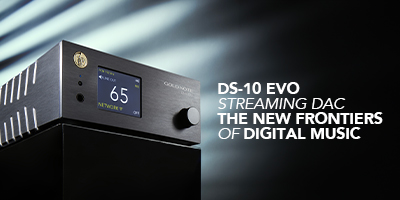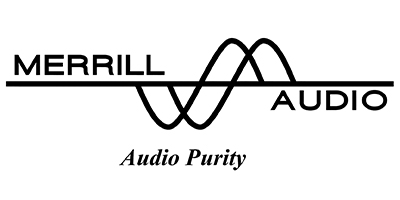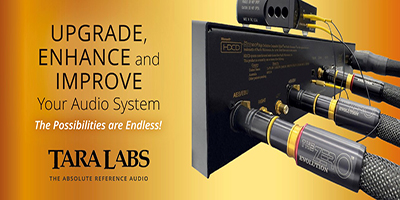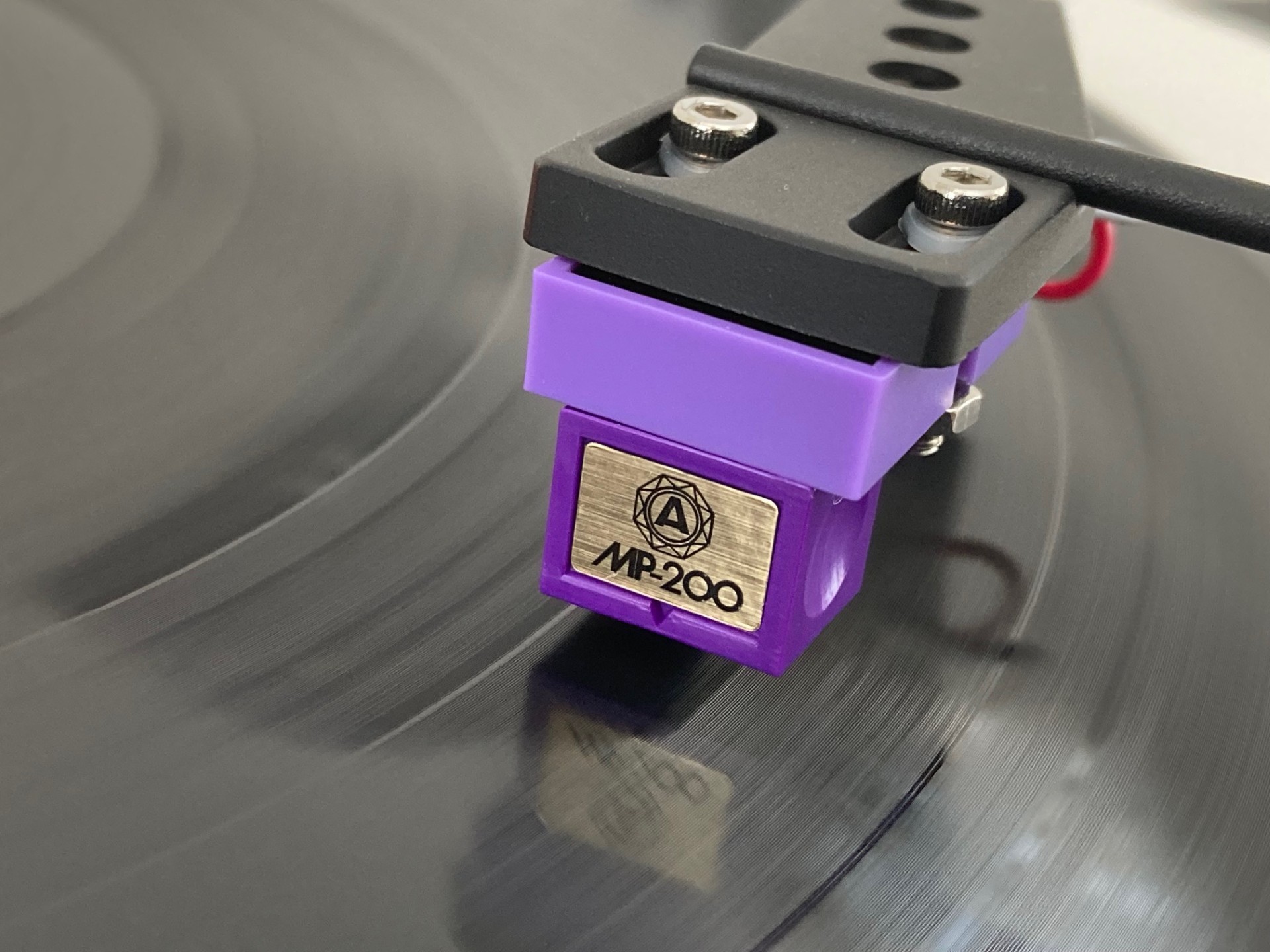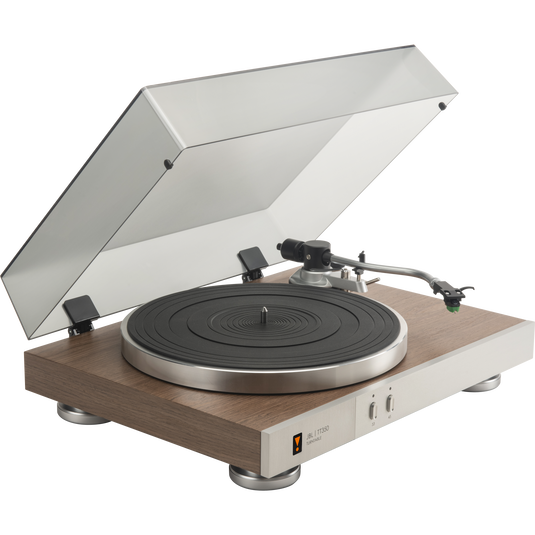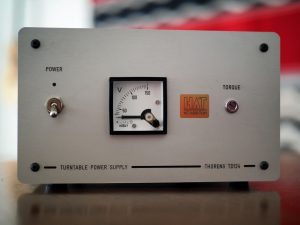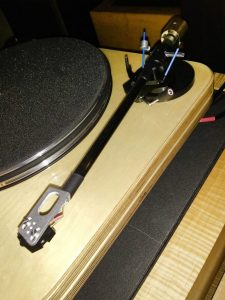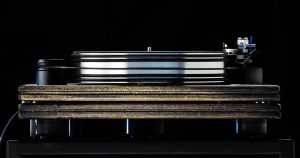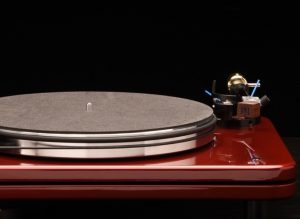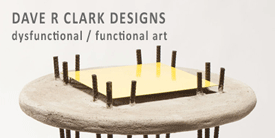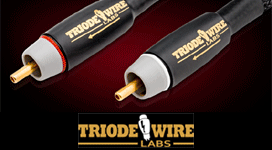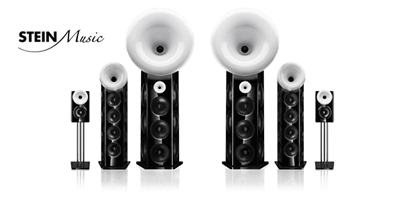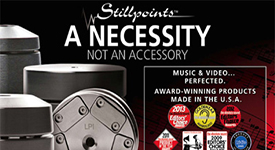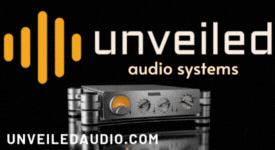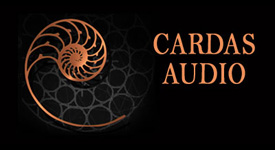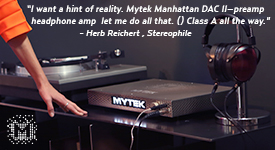
What happened to all of the luxury Japanese turntables? You know the ones I mean: those tall, chunky, rosewood-veneered JVCs and Denons and even Hitachis, with their fully-automatic feature sets, dead-on direct drive propulsion and wildly over-engineered parts like servo-damped tonearms? While other companies like Rega were trying to simplify turntable design, these folks were throwing money at creating mid-fi marvels. Well, CDs came along and, overnight, affordable engineering tour de forces were replaced by black plastic record spinners aimed at sad luddites who, inexplicably, still wanted to play records...at least, until they could afford to replace their scratchy old LP collections with CDs.
Well, Audio-Technica's AT-LP8x isn't quite a reborn classic, but it's just one sheet of carefully-applied rosewood veneer away from being a credible spiritual descendant. Sure, the tonearm doesn't have fancy electronic damping, and it's semi- rather than fully-automatic, but close enough. Sadly, unlike Music Hall which successfully recognized the retro appeal of throwing a little styling magic at their popular and good Classic turntable (HERE), Audio-Technica instead chose to make another foreboding all-black affair. I guess that's supposed to signal that it's a serious audiophile device and not a vintage-era throwback. Whatever, It's a missed marketing opportunity, for sure.
Moving on up
For about a nanosecond, the AT-LP8x was the flagship in Audio-Technica's turntable line. Then came the $2000 AT-LPA2 clear plexiglass thingie, and the AT-LP8x became a distant second banana; I guess plexiglass sells faster than wood veneer. No matter. The AT-LP8x, while more traditional than the AT-LPA2, is quite good—and more proof that the turntable market must be growing quickly, with other cartridge makers like Denon and Goldring getting back into the above-entry-level market. After all, why frustrate brand loyalists who want to throw more money at you, and who may also believe that staying in the family for cartridges and turntables make for guesswork-free synergy?
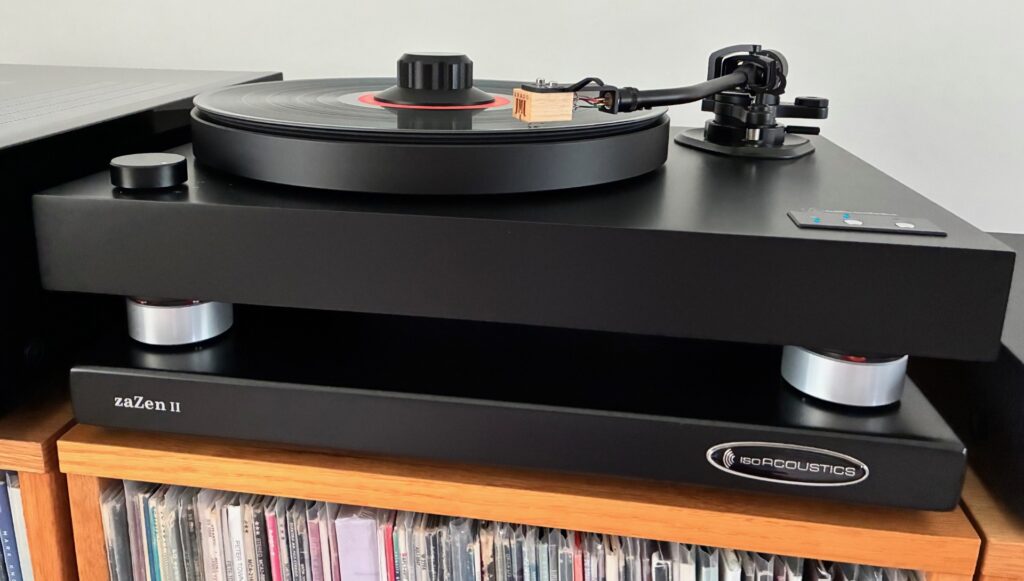
At $1299 in the US (a sharp and perhaps tariff-related rise from its $999 introductory price late last year), Audio-Technica's AT-LP8x is, to me, a less expensive, cut-from-the-same-cloth alternative to the $1699 Music Hall Stealth that I reviewed HERE. It's no less serious, with a similarly heavy MDF chassis and copiously damped aluminum platter, quality tonearm, low-torque direct drive motor, and a complete absence of newbie features like a built-in phono preamp or Bluetooth. And while both share the same dour and uninspired all-black appearance, they admittedly look better in person than in photos. It would not surprise me if they were manufactured in the same factory and share many parts; even the packaging for their included rubber mats are identical right down to the font.
Setting it up
Unpacking the AT-LP8x was fun and uneventful, but the only thing protecting its included dust cover—which is situated at the very top of the box—is the bed sheet-thin foam it's sheathed in and four flaps of cardboard. Ask your dealer to double box this, with some extra padding above the top, if that concerns you. Otherwise, this is as nicely and logically packed as any other Audio-Technica turntable. They do this well.
Assembly is super easy. There are no transport screws to remove (though there perhaps should be; more on that in a moment). Nor are there any complex assembly tasks aside from removing the usual bits of tape and padding. Simply screw the counterweight onto the tonearm, lower the platter gently into the spindle, and you're almost ready to go, aside from installing the headshell and pre-mounted cartridge, then setting the tracking force.
Encountering a problem
I did all of that, hit the start button to set the platter spinning and…scraaaapppppe…scraaaapppppe….scraaaapppppe. Something was grinding audibly and seemingly causing significant friction with every platter rotation, either inside the motor or spindle assembly. I removed the platter to investigate and there was nothing obvious to see. Next I turned the unit gently upside down to make sure something hadn't fallen inside the small gap between the spindle and plinth, but nothing did, or at least nothing that could be easily dislodged.
The selling dealer expressed surprise and told me this is the first issue they've had with an AT-LP8x, leading me to believe that it might have simply gotten banged around abnormally harshly during transit. Perhaps some transport protection for the drive system might be in order after all. Anyway, it was promptly replaced. Better than that actually—and this is a valuable lesson on why you should buy from a knowledgeable brick-and-mortar retailer rather than an Internet box pusher, even if you'll never set foot in their store. The dealer's tech called and kindly offered to check the replacement for proper operation before sending it, as long as I was okay with them breaking the box's seal. As expected, the second one operated without a hiccup and was completely untouched except where necessary. Shout out to Green Bay…you know who you are!
Admiring the build and features
The AT-LP8x is otherwise really nicely made. The platter is hefty, coated on the underside with a rubber-like material and doesn't ring. Its substantially finished MDF plinth makes for a sturdy base and has no manufacturing flaws or rough edges. While painfully ordinary looking, the feet do their job well, and I only replaced them with the very slightly superior Isonoe feet pictured because I have a set on hand. The tonearm is nice and precise, with no obvious slack or tightness in the bearings, and feels like it's of medium mass and above-average handiwork. Since it can't be removed, I can't compare it directly to anything else, but it certainly feels up to the standard of something on the affordable end from Pro-Ject or Rega.
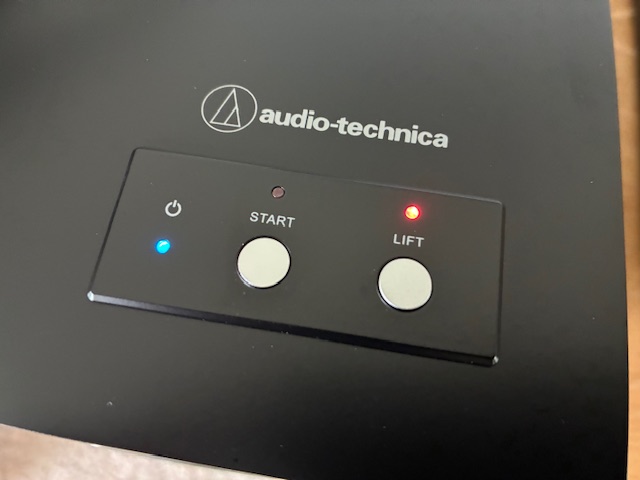
That tonearm's electronic cueing, actuated by a button near the front of the plinth, was one heck of a luxury: silent, silky, and a definite throwback to the days when Japanese brands would put on this kind of show simply because they could. But certainly it's not a necessity, and calling someone lazy or easily amused for liking it could certainly be tolerated as fair criticism. On the other hand, I've owned my share of similarly feature-rich turntables that I used more frequently than esoteric ones because they made playing records effortless…like a Denon DP-47F I alluded to earlier.
The cueing here is so gentle and precise it's a small marvel. Ditto the graceful auto-lift and platter stop that activates flawlessly within a few short seconds at the end of each record side, unlike some similarly-equipped tables that seem to turn forever before it's finally activated. Oddly though, while the arm descends immediately at the press of a button, there's a multi-second delay when ordering it to lift back up. It should also be mentioned that the arm defaults to the 'up' position when the unit is not in use or powered off, much like an old Dual CS-5000, if memory serves. If you're mounting and aligning a cartridge, you'll need to plug the table into a wall outlet and use the cueing button to lower it.
Will these features be the first to break, effectively leaving the user with a fully-manual table since there isn't a backup manual cueing lever? Only time will tell. Certainly, if we look at the vintage mid-fi turntable market, automatic features are one of the most common failure points. For now though, it's awesome, and since I could get run over by a bus long before it breaks, I'll worry about someday, someday. Kudos to Audio-Technica's thoughtful product planners for clearly thinking beyond the obvious. Turntables don't just sit there like a phono preamp, so the quality of user interactions matters. In this case Audio-Technica makes them fun and satisfying.
The AT-LP8x also comes with a crystal-clear hinged dust cover that's perfectly nice, and as an added bonus, a replacement costs about half as much as those from other manufacturers. Audio-Technica should be commended for keeping parts prices reasonable, and dealing with their parts department via email has always been a pleasant, efficient experience for me.
Clocking the tonearm
It's worth noting that this one has tons of flexibility to accommodate a wide range of headshells, cartridges and mats. There's a slick VTA adjustment at the rear of the base, which allows users to lift or lower it using a sliding lever instead of the Technics-style rotating ring. In addition, a sub-counterweight is provided that screws onto the back of the arm to allow for even heavier headshells and cartridges. If you lose it, you can replace it with one from a Technics 1200, as the threads are the same. There is no azimuth adjustment, which is where an excellent headshell like Audio-Technica's $109 AT-LH11H comes in. As good as the included headshell is, it's worth the additional outlay if you plan on really dialing in a more serious cartridge.
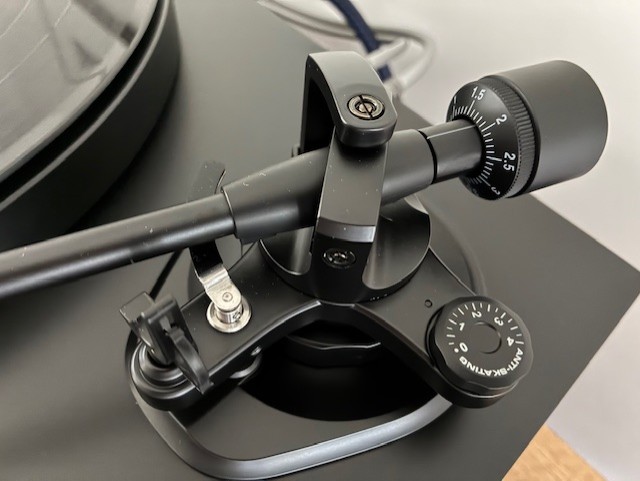
And as for tonearms with detachable versus fixed headshells, at this price point, I just can't fathom a clear performance advantage for the latter. Therefore, I'll take convenience and flexibility over the whole "increased rigidity" and "unbroken tonearm leads" argument. Maybe when it comes to tonearms costing more than the AT-LP8's total price, there's a difference. But having used (one piece) Rega and (detachable-headshell equipped) Jelco arms on my old Avid Diva II—admittedly an apples to oranges comparison—I'll simply say thanks to Audio-Technica for choosing the more practical of the two designs.
Swapping cartridges
I didn't spend much time using the included Audio-Technica AT-VM95E cartridge, $74 if purchased separately, which comes factory mounted and aligned on a quite nice AT-LT10 headshell, a new design that's also $74. As much as I like the cheaper conical AT-VM95c ($54 and reviewed HERE) and more expensive nude MicroLine-equipped AT-VM95ML ($179), I'm very familiar with the whole line, and while the bonded elliptical VM95E is likely the bestseller by far, for me it occupies a no-man's-land of sorts. It doesn't have the smooth, music-focused character of the conical, nor does it offer the precision of the higher models. Every time I've listened to it on this and other tables, it manages to remind me of how much I'd rather be listening to any of the other stylus profiles in the line.
Instead, I started off with a few familiar cartridges to get a baseline sense of what the AT-LP8x is like: Goldring's E3 ($189), Audio-Technica's AT-VM540ML ($279), Grado's Opus 3 ($300, reviewed HERE) and the recently introduced Ortofon MC X20 ($639, reviewed HERE), all through the Avid Pulsus phono preamp ($2399) or the inbuilt one in my Yamaha A-S1200 integrated amplifier. The results were very similar to the Music Hall Stealth, which is not surprising given their seemingly shared provenance and very similar construction.
The AT-LP8x, like all higher-class turntables, tends to elevate the performance of cheaper cartridges and rises to the challenge of supporting more expensive ones. Backgrounds are notably quiet, especially using the Ortofon or Grado, with notes emerging from relative silence with lifelike aplomb. The soundstage can be wide and deep, depending on the cartridge of course, but slightly less so than some similarly-priced belt drives I know. It goes deep and fairly high, but without the last smidgen of high-frequency air and space, giving it a somewhat warm character that can be counteracted somewhat with cartridges tending to be somewhat more bright and open up top. The motor, it should be noted, is well shielded, and there was no audible hum using the Grado.
Giving it a spin
Listening to the excellent Rhino reissue of the self-titled debut from The Cars with the Ortofon MC X20 and its nude elliptical stylus, the AT-LP8x boogies like a direct drive should, digs deep down in the bass region, starts and stops with precision, has good (but not explosive) slam and dynamics, and follows every thread of the (admittedly not especially complex) mix very well. The speed is dead-on and pitch is totally stable, suggesting that Audio-Technica is being conservative in its specs. Up the ante to classical music and this table is equally assured and confident, albeit just a little less able to fully delineate every single nuance and each individual instrument with the same precision. This is commensurate with its price, but by adding a more detail-oriented cartridge like Ortofon's 2M Bronze or Audio-Technca's VM540ML, some, if not all, of that particular criticism is mitigated. As with many tables in this price range, this one is capable of performance well beyond its cost by simply replacing the included cartridge. I'd certainly have no qualms about spending up to the price of, say, an Ortofon 2M Black, Nagaoka MP-500 or Audio-Technica AT-OC9XSH to max it out.
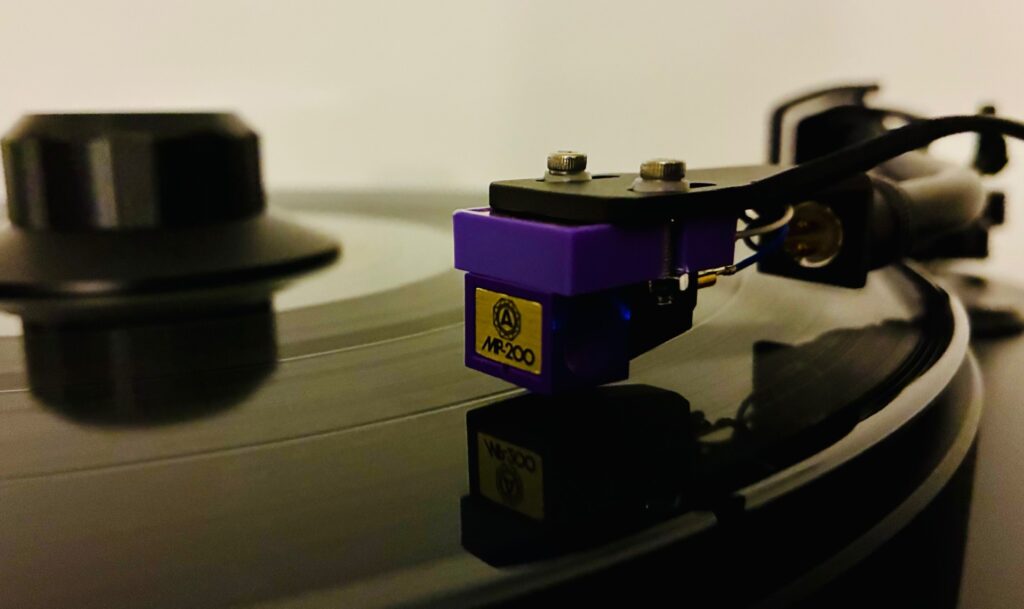
What we have then is the good and bad of extensive damping as a design philosophy. Yes, a heavily rubberized platter, moderately heavy arm and 'dead' MDF chassis will provide very quiet backgrounds and good dynamics (within a limited range), together with a healthy dose of audiophile traits like credible microdynamics, immersive detail, and a broad and relatively deep soundstage. Take that with a grain of salt since my engineering degree came courtesy of a classified ad in the back of Mother Earth News during the 1980s, but I was an attentive student and my GPA was a smiley face.
That still doesn't change what, for me, is the resulting design drawback: that somewhat dark sound. I've certainly heard the alternative in the form of overpriced "lifestyle" turntables I won't name with ringy platters and jangly tonearm bearings and pretty but resonant plinths that deliver commensurately grating high frequencies, disembodied bass and high noise floors. I'll take the AT-LP8x's compromises over those alternatives any day, since it keeps the pace well and consistently drew me into the music, despite not being knock-your-socks-off lively or airy, and lacking some sparkle. If you're looking for all that for $1299, you'll need to increase your budget substantially.
Not that the AT-LP8x is ever dull, or intentionally rolled off at the frequency extremes. It simply has a more mature and sober character that slots in anywhere but might partner most ideally with systems that verge on bright. The emphasis here is on voices, instruments and tonality...the 'meat' of the music, so to speak. When I say that it elevates the performance of inexpensive cartridges, I mean that in the same sense as transferring a set of all-season touring tires from a family sedan to a sports car: the sports car will work those tires harder than they'd ever be worked on the family hauler and will therefore get the most out of them, within their limits. This is a turntable that wrings out a good amount of detail and insight, again within its limits. Audio-Technica chose the compromises well.
Recommendations for upgrading
Like all turntables under several thousand dollars, this one benefits from the kind of tweaks that would drive up the stock unit's price of admission beyond what the market might bear, but which are nonetheless highly worthwhile. The advantage over a substantially more expensive table is that you can do these one at a time, as your budget allows. For instance:
1. Experiment with platter mats. The included rubber mat is fine, and you may like it, but it's kind of sticky and attracts dust and dirt like crazy. I like the thicker Oyaide BR-12 (about $60) better, as it provides similar performance without the cleaning issues and is also carefully dished to allow warped records to sit flat when aided by a clamp or weight. Cork-rubber mats, to me, sounded detailed and offered more delineation but in the end seemed to emphasize a rat-tat-tat musical flow rather than something more organic, though this quality may suit some listeners. A Herbie's Way foam mat produced less conspicuously delineated and detailed sound, but also added some sophistication in the form of subtly enhanced ease and depth.
2. Ditch the stock cartridge. Either change out the stylus for something in the same family, or go nuts trying just about anything you like. The arm can handle it in every way, from flexibility and adjustment range to sound quality.
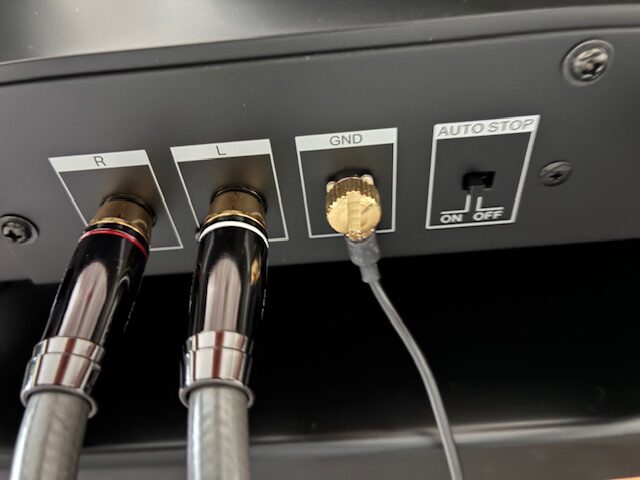
3. Try cables that don't shy away from treble detail. I didn't sample the included and seemingly very good quality stock cable, since I have no idea what its capacitance specs are. Instead I went with the notably clear-sounding QED Performance 40i (57 pF/m) at a reasonable, sub-$100 price tag. It's open, relatively transparent and fast-sounding if maybe a little more lean than rich—a perfect foil for the AT-LP8x.
4. The Line Phono Dubby record clamp and stabilizer ($24.95) is an absolute steal. It's lightweight (less than a pound) so it won't mess with bearings or speed controls, and the knurled handle makes it easy to screw down as well. This is very easy to use, almost free and combined with the Oyaide mat, very effective at less than $100 for both.
Comparing and contrasting
This isn't a comparison test, but it's hard to ignore the question: Is the $1699 Stealth worth an extra $400 over the AT-LP8? Well, the Stealth is weightier and comes with an Ortofon 2M Blue cartridge that costs over three times what the AT-LP8's AT95 does. It also has a ruled VTA adjustment tower making it easy to return to previous settings after switching cartridges, while the AT-LP8x offers a simpler though no less functional adjustment. The platters are similar as well as the mats. Both offer auto-stop at the end of the record, but the AT-LP8x has that trick electronic arm lift that feels like a gimmick until you get used to its push button convenience versus a traditional manual lever, as well as its silky and controlled up-and-down motion. Both are highly configurable and customizable for all kinds of headshells, cartridges, mats, cables and feet.
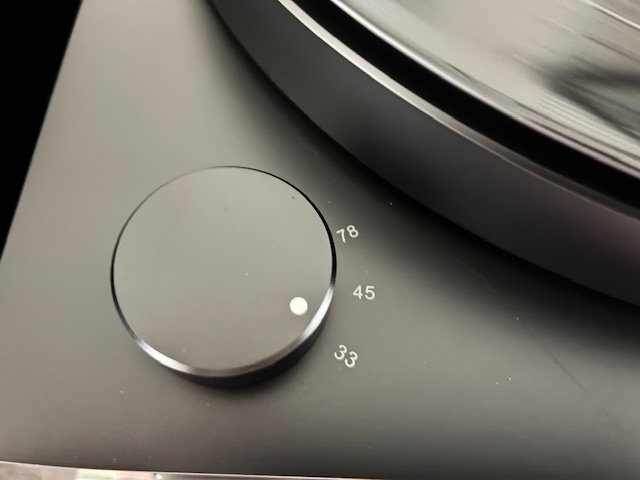
Over the long term—say, 10 years of ownership—I think the Stealth is worth the extra $40 a year, which amounts to a few coffees. Still, $400 is $400 and not everyone can make that stretch. Since they both sound very similar, though not exactly equal in overall performance, I guess it comes down to whether you want the Stealth's weightier build and handier tonearm versus the AT-LP8x's trick electronic arm controls. They're so close, if they were both offered by the same manufacturer, the AT-LP8x would be the Stealth's baby brother.
Then there's Technics, which is right in the same ballpark at $1299/$1399 for an SL-1200Mk7 (reviewed HERE) or SL-100c, or $1499 for an SL-1500C. I've listened extensively to the two former models, but have not tried the latter, though I expect it to be basically the same. These are exceptionally good, extremely well made, and have a nice and alert sound with less warmth than the AT-LP8x and more openness, though a perhaps more analytical character by comparison.
Taking one last look
I wish the AT-LP8x had a more open and sparkly treble, more heart-pounding macrodynamics and perhaps an even more expansive soundstage, but otherwise, it's a slick and nice way to listen to records. And, yeah, I also wish it was styled to look more like the vintage tables it could easily have been inspired by. On the other hand, one night during the height of allergy season, I could have sworn I was peering through watery eyes at the similarly dark-themed $6000 McIntosh MT3, minus its glass top and green accent lighting. So there's that.
It's up against talented competition, so it's hardly a no-brainer purchase, but given how easily upgradeable it is from cartridges and cables to mats and feet, this is something you're highly unlikely to outgrow until the time comes to step up to something costing 2-3 times as much. Anything in its price range is also likely to be more of a sideways move, sounding different but not mind-blowingly better. In that respect, it's hard to go wrong with an AT-LP8x.
For $1299, Audio-Technica's AT-LP8x is genuinely high end, albeit at the entry level of such: solid, quiet, precise, layered, stable, confident and substantial. If, like me, you're still stuck on what it could look like, well, according to Google Shopping, 4' x 8' sheets of rosewood veneer are on sale for just $4.29 per square foot. Two should be all it takes to do what needs to be done.
AT-LP8x turntable
Retail: $1299
Audio-Technica
Specifications
- Motor: DC servo
- Drive Method: Direct drive
- Speeds: 33-1/3 RPM, 45 RPM, 78 RPM
- Turntable Platter: Die-cast aluminum, rubber damper
- Starting Torque: 1.0 Kgf.cm
- Braking System: Electronic brake
- Wow and Flutter: < 0.1% (WTD) at 3 kHz (JIS)
- Signal-to-Noise Ratio: > 60 dB
- Cartridge Type: VM (AT-VM95EBK)
- Output Level: PHONO: 4.0 mV nominal at 1 kHz, 5cm/sec
- Power Supply Requirements: 100 to 240 V, 50/60 Hz
- Power Consumption: 8 W
- Dimensions: 450 mm (18") × 352 mm (14") × 161 mm (6.3") (W×D×H)
- Weight: Approx. 10.4 kg (23 lbs)
- Accessories Included:
・Dust cover
・Rubber mat
・Platter
・Dust cover hinges
・Counterweight
・Subcounterweight
・Headshell (AT-LT10) with VM stereo cartridge (AT-VM95E BK)
・45 RPM adapter
・RCA audio cable (Approx. 1.0 m (3.3'))
・Power cable (Approx. 1.8 m (5.9')) - Tonearm Type: Static balanced J-shaped tonearm
- Effective Arm Length: 247 mm (9.7")
- Overhang: 15 mm (0.59")
- Tracking Error Angle: Less than 2.0°
- Stylus Pressure Adjustment Range: 0.0 to 4.0 g
- Applicable Cartridge Weight: 14.0 to 20.0 g (including headshell; When using sub-counterweight: 17.5 to 23.5 g)
- Replacement Stylus: AT-VMN95EBK
- Replacement Headshell: AT-LT10

